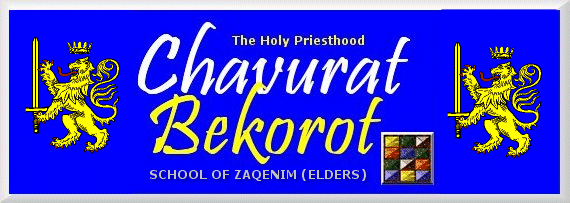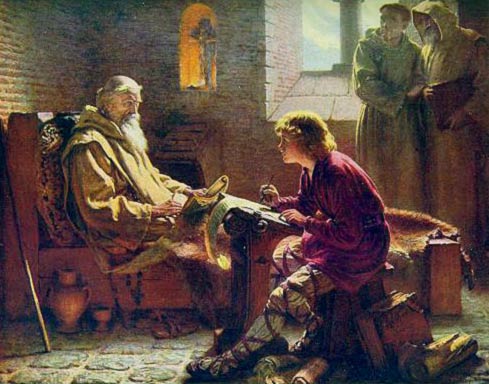
 21
JOHANNINE ESSAYS
21
JOHANNINE ESSAYS
 Similarities of the Second & Third
Similarities of the Second & Third
Epistles to the First Epistle
and Gospel of John
(3 November 1983)
by Christopher C. Warren, M.A.(Oxon)

Intro | 1 | 2 | 3 | 4 | 5 | 6 | 7 | 8 | 9 | 10 | 11
12 | 13 | 14 | 15 | 16 | 17 | 18 | 19 | 20 | 21
Both 2 John and 3 John are genuine epistles or letters, the first being addressed to "the elect lady" (probably a local congregation or the Messianic Community (Church) as a whole) [1] and the second to a faithful Christian called Gaius. In the Second Epistle, John commends the congregation for holding fast to the truth by living Yahweh's greatest commandment -- the oldest of all commandments, which is that love is the law of life. The commandment is to love, and love means to keep the commandments. The writer warns of false teachers who deny the historical Yah'shua (Jesus), and to be especially careful of those heretics whom he calls 'antichrists'. Those who do not have Yah'shua (Jesus) do not have the Father, but those who follow the correct teachings will possess both the Son and the Father. The antichrists are not to be received into the Messianic Community (Church) -- to fellowship with them is to participate in their evil.
3 John is a personal letter to a man dear to the writer's heart and who lives according to the 'truth'. Here the heretics, in the form of a local leader called Diotrephes, seem to have the upper hand. They do not recognise apostolic authority and seem to be excommunicating members of the congregation in sympathy with John and his co-workers. They lack love and are concerned with their own positions of power and are therefore, in the tone of 2 John, 'antichrists' (though they are not called by this name in 3 John).
1 John is called an 'epistle' though really it is more like a tract addressed to a particular situation. As in 2 John and 3 John, 1 John was written in response to the activities of false teachers who had left the Messianic Community (Church) and who were trying to seduce the faithful. However, in 2 & 3 John its seems as though the false teachers were still believing that they had superior knowledge to ordinary Christians (1 Jn.2:20,27, 2 Jn.9) and showing little love for them. These people are believed by many scholars to be the forerunners of the later heretics generally known as 'Gnostics'. The Gnostics denied that Yah'shua (Jesus) had come in the flesh amongst other things, which was a notable characteristic of the heretics in 2 John too. 1 John tells us that the false teachers thought themselves as being sinless (1 Jn.1:8,10) and although we are not told that this is how Diotrephes regarded himself in 3 John, he clearly lacked love and was well on the way to becoming a Gnostic-like heretic.
As in 3 John, there seems to be some doubt by some local Christians in 1 John of John's apostolic authority. He begins 1 John by explaining that he was an eyewitness to Yah'shua's (Jesus') mission and that this gave him a special authority to testify. In 3 John the apostolic authority is disregarded by those more interested in seeking power. The same situation may have been creeping into the Messianic Community (Church) in 1 John. Thus there are many similarities between 2 & 3 John and 1 John although 1 John says more doctrinally than 2 & 3 John. The purpose of 1 John was to assure its readers of their salvation -- the purpose of 2 & 3 John seems to have been to assure the faithful remnant of their salvation and to publicly condemn by name (3 John) those who had lost theirs.
The Gospel of John and 2 & 3 John perhaps have more differences than similarities but then their purposes are quite clearly different. The style of all the epistles is remarkably similar suggesting a common authorship, and is so similar to the Gospel of John as well that it is likely, from the internal evidence alone, that the gospel and the epistles were written by one man or school.
1 John's purpose, together with 2 & 3 John, is to confirm the faith in Yah'shua (Jesus) of the believers and develop the religious life of those who already believe. The Gospel of John, on the other hand, is of a much earlier date than 2 & 3 John, and was probably written at a time when Christian congregations were loosely organised and without properly constituted church officers (leaders). The purpose of the Gospel of John, then, is to promote faith in the Messiah (Christ). This being the case, the epistles are the natural sequence of the Gospel, putting into practice the spiritual witness gained by the believers from the latter. Nevertheless, there are some practical similarities between 2 & 3 John and the Gospel of John. In the Gospel, Yah'shua (Jesus) prophesies that the time would arrive when people would worship in spirit and truth (Jn.4:23). We find this happening in both 2 & 3 John, where Gaius and Demetrius are two such worshippers (and the author himself, of course). Yah'shua's (Jesus') parable of the sheep and the sheepfold, with the hireling who cares nothing for the sheep, foreshadows the antichrists in 2 John and Diotrephes in 3 John who are all hireling 'Christians' who care more for themselves than for the sheep (the Messianic Community or congregation of believers). Diotrephes and his kind totally fail the qualifications set out by Yah'shua (Jesus) in the Gospel for those who will eventually inherit eternal life. Yah'shua (Jesus) later said: "He who loves his life will lose it" (Jn.12:25); the antichrists and the Diotrephes' loved their lives more than their brethren and so lost them spiritually.
The Gospel of John is a message about 'love', 'light', and 'truth', all of which are fully realised in Yah'shua the Messiah (Jesus Christ). John takes the message on in 2 & 3 John where these qualities are to be found in the believers of the Messiah (Christ). Thus, though 2 & 3 John and the Gospel of John are somewhat separate in the historical development of the Messianic Community (Church), and even though their emphasis is slightly different, they are nevertheless closely related, the Gospel being in a sense the father of the epistles, or footnotes to the Gospel, the prophetic realisation of the sayings of Yah'shua (Jesus).
Endnotes
[1] Some scholars (principally Roman Catholic) make a case for this being the mother of Yah'shua (Jesus), and this is certainly a possibility, and yet others have suggested that this might be a wife of Yah'shua (Jesus). The traditional understanding is the more plausible one.
References
- The Three Schools of Gnosticism in Unravelling the Gnostic-Mormon Connection
Intro | 1 | 2 | 3 | 4 | 5 | 6 | 7 | 8 | 9 | 10 | 11
12 | 13 | 14 | 15 | 16 | 17 | 18 | 19 | 20 | 21


This page was created on 1 March 2004
Updated on 1 March 2004
Copyright © 1987-2008 NCCG - All Rights Reserved



